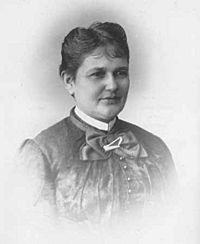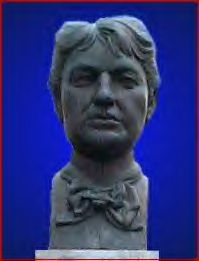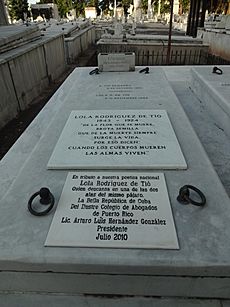Lola Rodríguez de Tió facts for kids
Quick facts for kids
Lola Rodríguez de Tió
|
|
|---|---|

Lola Rodríguez de Tió
|
|
| Born | Dolores Rodríguez de Astudillo y Ponce de León September 14, 1843 San Germán, Puerto Rico |
| Died | November 10, 1924 (aged 81) Havana, Cuba |
| Occupation | poet |
| Nationality | Puerto Rican |
Lola Rodríguez de Tió (born September 14, 1843 – died November 10, 1924) was a very important poet from Puerto Rico. She was the first woman born in Puerto Rico to become famous as a great poet all over Latin America. Lola believed strongly in women's rights and worked to end slavery. She also fought for Puerto Rico to become independent.
Contents
Lola's Early Life and Education
Lola Rodríguez de Tió was born as Dolores Rodríguez de Astudillo y Ponce de León in San Germán, Puerto Rico. Her father, Sebastián Rodríguez de Astudillo, was a founding member of a group for lawyers in Puerto Rico. Her mother, Carmen Ponce de León, was a descendant of Juan Ponce de León. He was a famous explorer and the first Spanish Governor of Puerto Rico.
Lola was taught at home. She loved reading and literature her whole life. She especially found inspiration in the works of a writer named Fray Luis de León. Lola was very independent, even when she was young. At 17, she insisted on wearing her hair short, which was unusual for women at that time. This became her unique style.
A Voice for Change: Political Activism
Lola moved to Mayagüez with her family. There, she met Bonocio Tió Segarra, and they married in 1863. Lola became a writer and also imported books. She often wrote articles in local newspapers. She was a strong activist against the Spanish government, pushing for change as much as she could.
After marrying, she published her first book of poems called "Mis Cantos" (My Songs). It sold an amazing 2,500 copies, which was a lot for that time!
Exile and Continued Fight for Freedom
Because of their activism, Lola and her husband were sent away from Puerto Rico by the Spanish governors two times. The first time was in 1867, and the second was in 1889. During their first exile, they went to Venezuela. For their second banishment, they first moved to New York. There, Lola helped José Martí and other Cuban revolutionaries who were fighting for Cuba's freedom. Later, they moved to Cuba. They lived there for the rest of their lives.
Their home in Cuba became a meeting place for important politicians and thinkers. Many Puerto Ricans who were also exiled gathered there. In 1868, Lola was inspired by Ramón Emeterio Betances's fight for Puerto Rico's independence. She was also moved by an attempted revolution called the Grito de Lares. Because of this, she wrote new, patriotic lyrics for an existing song called La Borinqueña. This song later became the official anthem of Puerto Rico.
In 1901, Lola helped start the Cuban Academy of Arts and Letters and was chosen as a member. She also worked as an inspector for the local school system. She was very well-known in Cuba for her patriotic poems about both Puerto Rico and Cuba. Some of her most famous works include "Cuba y Puerto Rico son..." (Cuba and Puerto Rico are...) and "Mi Libro de Cuba" (My Book about Cuba).
In 1919, Lola Rodríguez de Tió returned to Puerto Rico. She was honored with a big celebration where she read her poem "Cantos a Puerto Rico." Lola Rodríguez de Tió passed away on November 10, 1924. She is buried in the Colón Cemetery in Havana, Cuba.
Lola's Lasting Legacy
Many people believe that the design and colors of the Puerto Rican Flag, which was officially adopted in 1954, came from Lola Rodríguez de Tió's idea. She thought Puerto Rico should have a flag similar to Cuba's, but with the colors reversed.
Puerto Rico has honored Lola's memory in many ways. Schools and streets have been named after her. On May 29, 2014, the government of Puerto Rico honored 12 important women. They placed plaques for them in a special plaza in San Juan. Lola Rodríguez de Tió was one of these honored women. She was recognized for her great achievements and her important place in Puerto Rican history.
The Revolutionary "La Borinqueña"
Lola Rodríguez de Tió wrote powerful lyrics for "La Borinqueña" in 1868. These words encouraged people to fight for freedom and independence. They spoke about waking up and fighting for their homeland. Her version of the song became a symbol of the independence movement.
See also
 In Spanish: Lola Rodríguez de Tió para niños
In Spanish: Lola Rodríguez de Tió para niños
- List of Puerto Ricans
- List of Puerto Rican writers
- Puerto Rican literature
- History of women in Puerto Rico
19th-century female leaders of the Puerto Rican Independence Movement
Female members of the Puerto Rican Nationalist Party
- Blanca Canales
- Rosa Collazo
- Lolita Lebrón
- Ruth Mary Reynolds
- Isabel Rosado
- Isabel Freire de Matos
- Isolina Rondón
- Olga Viscal Garriga
Articles related to the Puerto Rican Independence Movement
- Puerto Rican Nationalist Party Revolts of the 1950s
- Puerto Rican Nationalist Party
- Ponce massacre
- Río Piedras massacre
- Puerto Rican Independence Party
- Grito de Lares
- Intentona de Yauco
- United States of Banana



